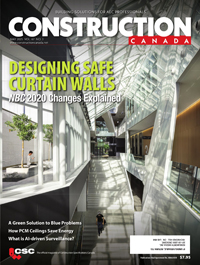Glass claddings for tall buildings

Window-to-wall ratios
The WWR is typically expressed as a percentage and represents a building’s total visible glazing area divided by its total exterior envelope area. This important variable directly affects energy performance in buildings given the window area impacts heating, cooling, and lighting needs. (This comes from John Straube’s 2012 publication, “High-performance Enclosures” [Building Science Press].) Relatively large glazing areas can help reduce the electric lighting load of buildings with increased daylight. Solar gain through windows can also reduce the heating load in the winter, but that same heat gain in the summer is one of the main causes of increased cooling loads. Further, glazing assemblies generally have significantly worse thermal resistance compared to typical opaque wall assemblies, which makes them cold during the winter. Consequently, the objective of placing a limit on window areas is to reduce the heating load in winter and the cooling load in summer.
Despite WWR restrictions becoming stricter in the last 20 years (Ontario’s prescriptive maximum WWR is now 40 per the 2012 Ontario Building Code [OBC]), the WWR of tall residential buildings in Toronto is trending higher (Figure 3). Large window areas are big selling points for condominium units, and developers are using the performance compliance path of the code to provide larger window areas than permitted by the prescriptive path. Performance-based compliance relies on whole-building energy modelling and typically uses efficient active systems such as HVAC and lighting to make up for poor building envelopes.
OBC introduced two supplementary standards to improve energy efficiency:
- SB-12 for low-rise (four or fewer storeys) residential buildings; and
- SB-10 for all other buildings, including high-rise commercial and residential.
One of the main challenges when it comes to the WWR of tall towers is the fact both residential and commercial buildings are controlled by the same code, while their use and, most importantly, their compartmentalization levels are vastly different. Commercial buildings often have large open spaces on each floor, allowing light from different directions to get into the space, while residential towers are highly compartmentalized and have much smaller units with only one or two walls (for corner units) to the outside. Further, the occupants in commercial buildings usually use the facilities between eight and 10 hours a day, while residential occupants obviously live in their units.

From a strict code perspective, SB-10 has a prescriptive maximum of 40 per cent WWR for both residential and commercial tall towers. SB-12 has a prescriptive maximum WWR of 17 per cent, but can go as high as 22 per cent if windows with better U-values are used. However, the rules for calculating the WWR in the two standards differ substantially. This inconsistency is explained in the following paragraphs, followed by an alternative and more consistent measure of WWR.
For low-rise detached single-family homes in SB-12, the 17 to 22 per cent WWR is calculated based on the building’s entire vertical enclosure area as demonstrated by the shading in the left half of Figure 4. With windows located over four walls, light can enter the living space from all directions. The WWR is calculated as:
When calculating the enclosure area for attached low-rise units such as townhomes, SB-12 A-2.1.1.1.(7) (8) and (10) explains:
For attached homes, the above grade portions of the walls that are common to other conditioned units are also included in the wall area.
The equation to calculate the WWR in this case is:
As shown in the right-side portion of Figure 4, the interior common walls are included in the calculation for the WWR. Since interior common walls cannot have windows, the total window area can be placed in the two exterior walls, allowing significant light to enter the living space from two directions.





